Major Arthur Kenlis Maxwell, 11th Baron Farnham, DSO
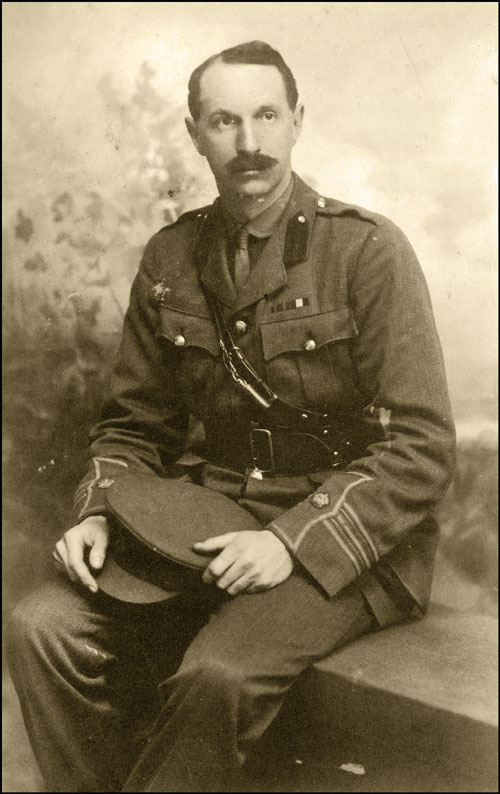
Lieutenant-Colonel Arthur Kenlis Maxwell, 11th Baron Farnham, was born on 2 October 1879, son of Somerset Maxwell and Lady Florence Jane Taylour. He inherited the Farnham estate in County Cavan on his father’s death in 1900.
Farnham was educated at Harrow (1893-98) and Sandhurst. He was commissioned as a 2nd lieutenant in the 10th (Prince of Wales Own Royal) Hussars on 12 August 1899, and was promoted to lieutenant on 1 April 1900. He served in the Boer War from 1899 to 1902. Following a period of ill-health, Farnham resigned his commission on 29 March 1905.
On 27 May 1905 he received a commission as captain in the North of Ireland Imperial Yeomanry, transferring to the newly-formed North Irish Horse in July 1908. Farnham commanded D Squadron (Dundalk) of the Yeomanry from 1907 to 1908, and B Squadron (Londonderry) of the NIH from 1913 to 1914. He also led the County Cavan regiment of the UVF. He was promoted to the rank of major on 20 November 1912.
On the outbreak of war Farnham took command of the North Irish Horse depot at Londonderry, bringing his men to Antrim at the end of 1914. In mid-1915 he embarked for England with F Squadron, based at Hemel Hempstead in Hertfordshire.
Soon after, Farnham was appointed to the headquarters staff of the 36th (Ulster) Division, travelling to France at the end of September 1915. He remained in this role until July 1916, when the division’s commanding officer reluctantly agreed that he return to the North Irish Horse.
After seeing the early fighting with his squadron at Third Ypres, on 22 September 1917 he took command of the 10th Battalion, Royal Inniskilling Fusiliers, with the rank of lieutenant-colonel. The battalion played a significant role in the Battle of Cambrai, and Farnham was mentioned in despatches (London Gazette 11 December 1917). In February 1918 the battalion was disbanded and Farnham took command of the 2nd Battalion, Royal Inniskilling Fusiliers.
Farnham was captured at Boadicea Redoubt south west of St Quentin on the first day of the German Kaiserschlacht offensive in March 1918. According to German records, the 2nd Inniskillings, surrounded by overwhelming forces, were offered the choice of surrender or destruction by heavy artillery bombardment:
... a few minutes later, there filed out of the redoubt a lieutenant-colonel, carrying a small white dog, three captains, seven subalterns and 241 other men. Forty-one machine-guns and mortars were found in the redoubt. The British lieutenant-colonel asked for, and was given, a document stating that he had put up a good fight before surrendering.
(Martin Middlebrook, The Kaiser's Battle.)
He spent the remainder of the war as a prisoner of war. During this time he was mentioned in despatches once again and awarded a Distinguished Service Order for his role in the fighting in March.
Farnham resigned his commission on 2 October 1929, having reached the mandatory retirement age. He died on 5 February 1957.
During the war two of his young sons died at home of illness. His third son, Somerset, died of wounds in North Africa in 1942.
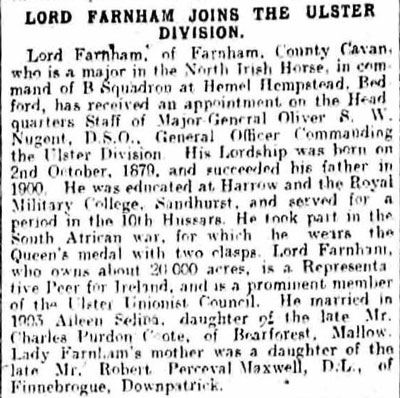
The Belfast News-Letter, 7 October 1915

Farnham (standing second from right) as a prisoner of war in Karlsruhe, Germany.

Belfast News-Letter, 9 January 1919
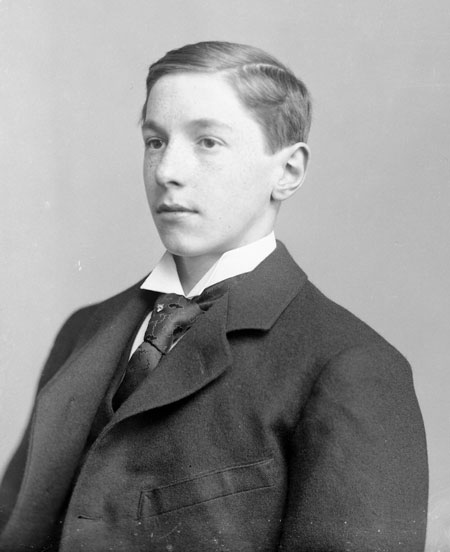
Farnham at Harrow (1893-98)
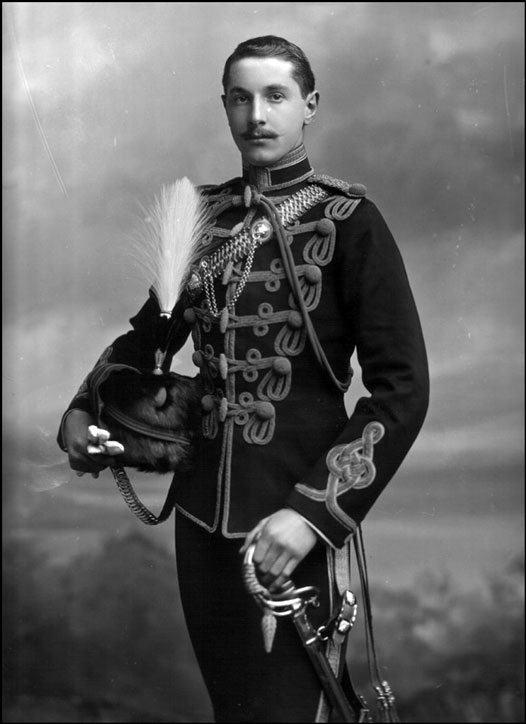
Farnham in 1899 as a 2nd Lieutenant in the 10th (Prince of Wales Own) Hussars
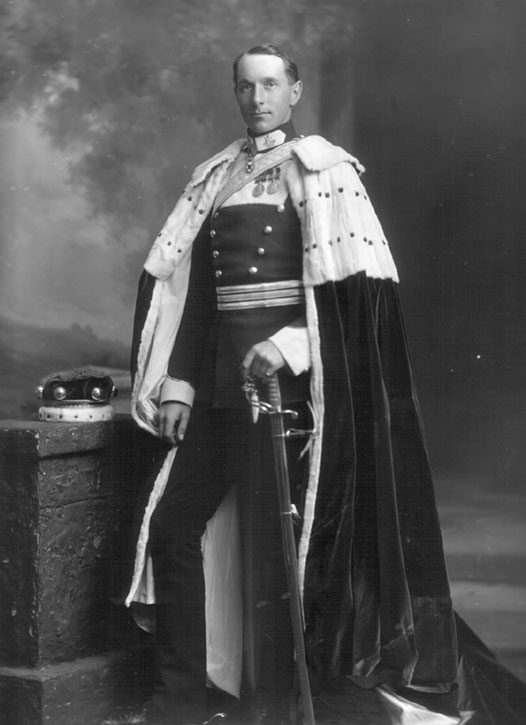
Farnham in peer's robes over full dress uniform, Captain, North Irish Horse, on the occasion of the coronation of King George V, 23 June 1911
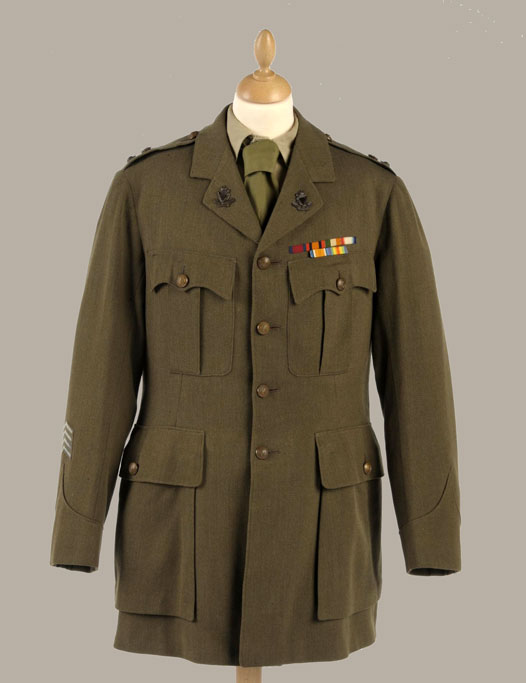
Farnham's service jacket, on display in the National Museum of Northern Ireland
Images 1 and 3 sourced from Brendan Scott, Farnham: Images from the Maxwell Estate, Co. Cavan, Wordwell, Dublin, 2010; image 5 from Harrow School Photographs Of Pupils & Masters 1869-1925 sourced from Find My Past; images 6 and 7 sourced from Victoria & Albert Museum, Lafayette Studio collection http://lafayette.org.uk/intro.html
